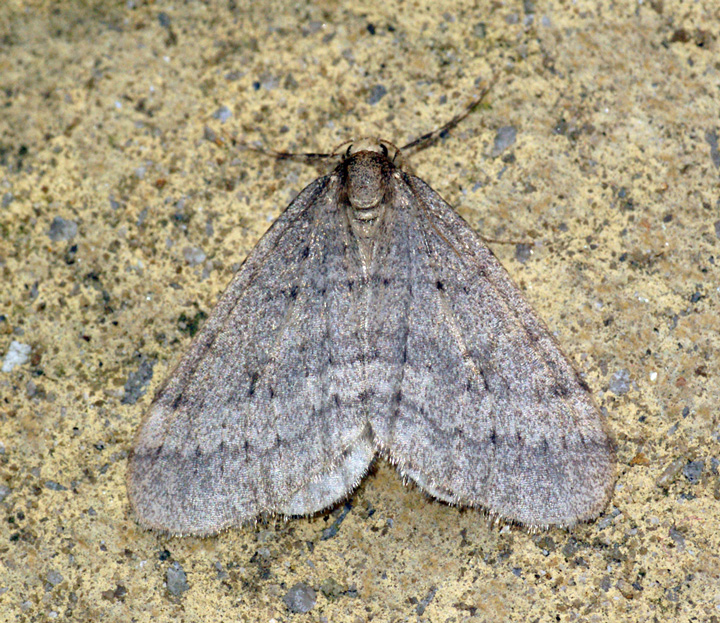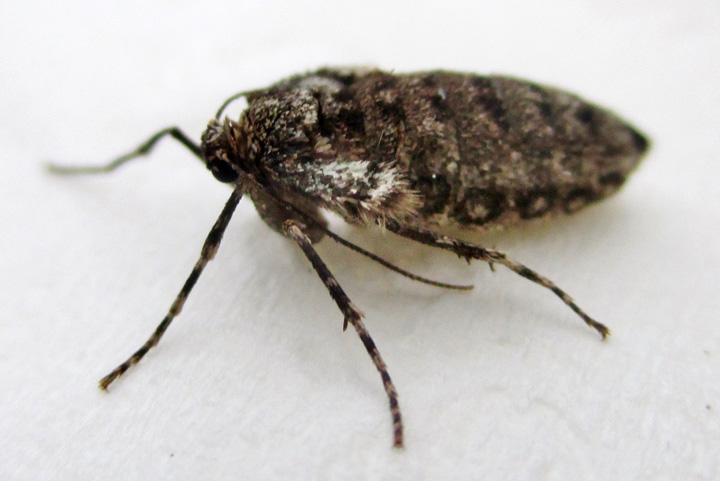Insect Identification
Emerald Ash Borer

- Found in or near the canopies of Ash trees. Rarely seen on the ground.
- Adult Emerald Ash Borers are metallic green, narrow and approximately ½” in length.
- Emerald Ash Borer larvae are white or opaque and have bell or barb shaped segments and are ½” to 1 ½” in length. The larva can be found year round in the cambium layer of any ash tree beneath the bark.
Find more information from the State of Maine here:
What does an Emerald Ash Borer look like?
Signs and Symptoms of Emerald Ash Borer Infestation

Browntail Moth Identification



Most commonly found in red oaks, apple, and crabapple trees
- Adult BTM: white, “hairy” moth with reddish-brown antennae and tip to its abdomen
- Caterpillars: two red dots near their rear end and parallel white markings along their sides
- Both caterpillars and Adult Browntail moths have toxic hairs: the hairs can cause rashes, respiratory symptoms (asthma) and eye irritation. The hairs can remain toxic for 3 years.
Sightings begin in July- adult moths lay eggs near the tips of branches, then die soon after. After about a month of incubation the eggs hatch and the tiny caterpillars feed on the leaves; due to their size (about ¼ inch) they don’t do much damage to the trees. At this stage they form protective nests by folding one or more leaves together with silk and spend the winter in them. In early May the caterpillars come out of hibernation and begin to feed on new leaves until mid-June, when they can reach an inch or more in size. This is when they become destructive and can defoliate a tree.In mid-June the caterpillars form cocoons and metamorphose into adults.
Find more information from the State of Maine and the US Department of Agriculture here:
Browntail Moth Fact Sheet
Browntail Moth Brochure

Hemlock Woolly Adelgid

- Found in eastern hemlock in many coastal and southern towns in Maine. Including Midcoast Maine towns of Owls Head and Friendship.
- Hemlock Wooly Adelgid or HWA is an aphid-like insect that came to the US from Asia and is noted by woolly, waxy masses typically near the ends of new growth on hemlock trees usually on the underside of the foliage.
- HWA causes the needles of hemlock trees to discolor and fall off early which leads to less growth, degradation of a tree’s crown, and potentially death of the tree.
- This insect is spread by wind, birds, and other animals.
Find more information from the State of Maine here:
Hemlock Woolly Adelgid – Adelges Tsugae
Hemlock Woolly Adelgid in Maine
Hemlock Wooly Adelgid Fact Sheet
Tent Caterpillar


- Forest tent caterpillars are found primarily in poplar, oak, birch and maple trees and while they do not build nests, they leave behind mats of silk threads on the trees that they travel and rest within.
- Eastern tent caterpillars are found in apple, cherry, and crabapple trees. Their nests are visible in the forks of trees.
- Large numbers of these caterpillars consume large amounts of the foliage of host trees and while this does not generally kill the trees directly, it leads to reduced tree growth and makes trees vulnerable to other insects, disease, and over time can kill a tree.
Find more information from the State of Maine here:
Forest and Eastern Tent Caterpillars Fact Sheet


Gypsy Moth


- Found in hardwoods other than ash trees. This insect feeds on oak, gray birch and fruit trees like apple, crabapple, and cherry. Larvae also feed on evergreen trees. If food becomes scarce in an area infested with these insects, they will also feed on shrubs and ornamental tree foliage.
- Like the browntail moth, the fine hairs of gypsy moth caterpillars can irritate the skin and cause rashes and itching.
- Gypsy moth caterpillars start out at approximately 1/16th inch and moult 5 or six times before they reach full size at 1 ½ to 2 ½ inches.
- Defoliation of trees is caused primarily by growing caterpillars. While this does not typically directly kill a tree, it does cause reduced growth and make the tree more vulnerable to other insect infestations, diseases, or death if the tree is affected by other factors like poor soil conditions.
- Egg masses are found on house siding, foundations, and trees.
Find more information from the State of Maine here:
Gypsy Moth Fact Sheet


Winter Moth


Adult Male Winter Moth
- Adult moths will feed on the foliage of many deciduous trees and shrubs, though they prefer oak, apple, elm, ash, crabapple, cherry, and blueberry. Larvae are known to feed on other plants as well.
- Larvae hatch in early spring and can heavily defoliate trees and shrubs. Trees that experience this level of defoliation can exhibit branch dieback and in some cases mortality, if left untreated.
- Mature larvae will pupate in the soil beneath trees and the surrounding area, forming earthen cocoons that they remain in from June-November. They are well protected during this time and unaffected by pesticides.
- Adult moths emerge in November. While able to survive in freezing temperatures, they are most active when temperatures are above freezing.
Find more information from the State of Maine here:
Winter Moths in Maine

Adult Male Winter Moth

Adult Female (Flightless) Winter Moth
Japanese Beetle


- Found on over 400 plants, Japanese beetles most commonly seen on the leaves of beans, raspberries, black raspberries, grapes, roses and blueberries.
- Japanese beetle larvae(grubs) are similar to June bug larvae and are white and found in lawns and turf sod. Commonly, skunks will dig up lawns to feed on these grubs. Like the June bug grubs, Japanese beetle grubs can destroy lawns by consuming root systems if untreated.
- Adult Japanese beetles feed in mass leaving behind lace-like leaf remains and reducing plants foliage.
Find more information from the State of Maine here:
Japanese Beetle Fact Sheet


Photo Credits: Chris Cooper; cham0138; Ben Sale; Wang, et al.; Katja Schulz; Aaron Carlson; gailhampshire; Emilia.venturato; David Cappaert, Michigan State University, United States; C Watts; Ben Sale; gbohne.
Some Rights Reserved: CC 2.0, CC 3.0, CC BY-SA 3.0
